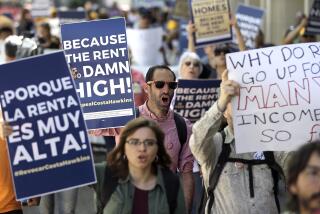L.A. Rent-Control Panel Offers a Preview of City Council Showdown
- Share via
The results are sure to be muddy Of a committee-supervised study. No one will confess Any fault for the mess Or for making the meetings so bloody. It didn’t take the city bureaucrat long to doodle that verse following last week’s bitter session of the blue-ribbon panel commissioned by City Council to dissect Los Angeles’ six-year-old rent-control law.
And if the turmoil surfacing in the panel is a harbinger, then this spring’s council showdown on the sensitive issue should be a real donnybrook.
From almost the first meeting of the nine-member Rental Housing Study Steering Committee nearly a year ago, the battle lines have been emphatically drawn between landlord and tenant constituencies.
Attempting to keep order, in a meeting place tucked away in an aging office building off Spring Street, is Barbara Zeidman, a career city bureaucrat who also heads the city’s Rent Stabilization Division, part of the Community Development Department. Both the landlord and tenant representatives have accused her of selling out one side at the expense of the other--charges which the normally unflappable Zeidman unequivocally denies.
The two key protagonists are Bob Smith, the property-owner representative and president of Ring Brothers Management Co., a big property-management firm, and attorney William Barth, the tenant representative. At Smith’s elbow as an adviser is George Mihlsten, a lawyer with the firm of Latham & Watkins who lobbies against rent control at City Hall. Usually giving Barth a sympathetic ear is panel member Richard Solomon, a law professor and member of the city’s Rent Adjustment Commission. Other members include a trade-union representative and city bureaucrats.
The group’s mission is to fashion a landmark rent-control study by the end of February, laying the foundation for City Council to go to the mat on the future of a law that affects about 1.5 million tenants in the nation’s second-largest city. Virtually no one, however, expects council members to tackle the issue before the April 9 city elections.
Under the current permanent ordinance, there is a 7% annual cap on rent hikes in the city, plus an allowance for capital improvements. When a tenant vacates, the unit is decontrolled and the landlord can charge a new tenant whatever the market will bear. But once the tenant moves in, the 7% annual-increase ceiling takes effect again.
How this formula is working in terms of landlord profits and tenant burdens, and what new rent-control formulas can be devised, will constitute much of the study’s focus.
Commissioned to build the data base to which the $500,000 study will be tied is a Los Angeles consulting firm, Hamilton, Rabinovitz, Szanton & Alschuler, which last month generated a 92-page report designed to provide a framework for the project. At the same time, subcontractors are surveying landlords and tenants with the aim of providing some solid data for the final report to City Hall.
Tempers were already frayed before the Hamilton report surfaced. Almost at the outset, landlord and tenant coalitions were accusing each other of attempting to stack the way the surveys would be designed.
But things came to a boil last week when tenant representative Barth’s eyes fell on Page 27 of the Hamilton report, which listed seven rent-control formula options. The last one was pegged to a “phase-out (of) rent control within five years.”
Barth became livid. He accused Zeidman of a double-cross, asserting that she had assured him both privately and before the panel that ending rent control would never be an option. “It’s a personal breach of faith,” he said, threatening to resign from the panel.
Zeidman declared that she was only interpreting the options she thought City Council wanted on its menu when it took up the issue. Council members, Zeidman said, should have “the upside and the downside” of rent control. In the end, however, she conceded that “the focus of the study is not to do away with rent control.” The phase-out language was deleted.
Other tentative proposals in the Hamilton report call for variations on tying the annual allowable rent increase to the consumer price index or to landlord profits or rate of return on a property. A controversial approach, also heatedly opposed by Barth, would be a so-called vacancy decontrol tax on landlords in exchange for a unit’s permanent deregulation. This is also expected to be deleted. On the tenant side, the issue of whether to allow vacancy decontrol at all is raised, or whether to move to a tougher Santa Monica-type law that doesn’t allow even temporary decontrol when a tenant vacates.
What the warring panel factions appear to be missing is that the study is just that--only recommendations to City Council. If lawmakers don’t like them, they’ll toss the $500,000 opus into the nearest wastebasket and reshape the law from scratch. The result could lead to a new and tougher law, or no law at all.
Whatever the case, Michael B. Teitz, a UC Berkeley urban planning professor and the steering committee’s chief consultant, isn’t particularly moved by all of the rhetoric so far. “I’ve never seen a survey that couldn’t be improved,” he said during a lull in the recent war of words. So far, he added, “we’ve had a lot of hyperbole.”
More to Read
Sign up for Essential California
The most important California stories and recommendations in your inbox every morning.
You may occasionally receive promotional content from the Los Angeles Times.













